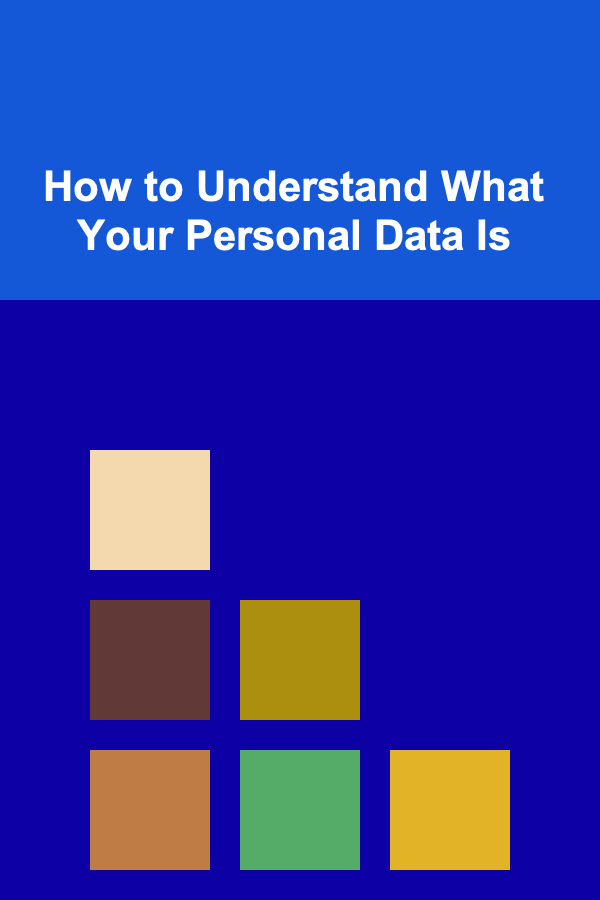
How to Understand What Your Personal Data Is
ebook include PDF & Audio bundle (Micro Guide)
$12.99$9.99
Limited Time Offer! Order within the next:

In today's interconnected world, personal data has become a valuable asset, often driving business models, technologies, and innovations. It is increasingly being collected, processed, and analyzed by a wide range of organizations, from social media platforms to healthcare providers. However, many individuals are unaware of the exact nature of their personal data, how it is used, or how it impacts their lives.
This article delves deep into the concept of personal data, helping you understand what it is, how it is collected, and what your rights and responsibilities are. By the end of this exploration, you will be better equipped to navigate the modern digital landscape and protect your privacy.
What Is Personal Data?
Personal data refers to any information that relates to an identified or identifiable individual. This can include a wide range of details, from basic information like your name, address, and phone number, to more complex data like your online behaviors, preferences, and even genetic makeup.
The European Union's General Data Protection Regulation (GDPR) offers a broad and inclusive definition of personal data, emphasizing that it includes any data that can directly or indirectly identify a person. In essence, personal data is any information that, when combined with other data, can lead to the identification of an individual.
Types of Personal Data
Personal data can be categorized into several types, based on its nature and sensitivity:
1. Basic Identifiable Information
This is the most common and direct form of personal data. It includes:
- Name: Full names or even just a first name can be considered personal data.
- Contact Information: Email addresses, phone numbers, physical addresses.
- Identification Numbers: National ID numbers, passport numbers, driver's license numbers.
2. Sensitive Personal Data
This category is more sensitive and requires greater protection due to its potential to harm individuals if misused. Examples include:
- Health Data: Medical records, prescriptions, health conditions.
- Biometric Data: Fingerprints, facial recognition data, iris scans.
- Racial or Ethnic Origin: Information about one's racial background.
- Religious or Philosophical Beliefs: Data on your beliefs or religious practices.
- Sexual Orientation: Information regarding sexual preferences.
Sensitive data is typically subject to stricter legal regulations and can only be processed under specific conditions.
3. Behavioral Data
In today's digital era, a significant amount of personal data comes in the form of behavioral data. This includes:
- Web Activity: Browsing history, search queries, click patterns on websites.
- Social Media Engagement: Posts, likes, shares, comments.
- Location Data: Geolocation from GPS-enabled devices.
- Purchasing Behavior: Online purchases, preferences, product reviews.
4. Psychographic Data
Psychographic data includes more in-depth insights into an individual's attitudes, interests, and values. This type of data helps businesses understand consumer behavior on a deeper level. Examples include:
- Hobbies and Interests: Data on activities you enjoy.
- Personality Traits: Insights derived from interactions or surveys.
- Lifestyle Preferences: Information about how you live, travel, or work.
This data is often used by companies to tailor advertisements, content, and services to fit your preferences.
How Is Personal Data Collected?
Personal data is collected in many ways, often without users realizing the extent of the information being gathered. The following are some common methods of data collection:
1. Direct Collection from Individuals
This is perhaps the most obvious form of data collection, where individuals willingly provide their personal information. Examples include:
- Registration Forms: Signing up for a website or service often involves entering personal details like your name, email address, and password.
- Surveys and Polls: Participating in surveys or questionnaires typically results in the collection of demographic, behavioral, or psychographic data.
- Customer Support Interactions: Engaging with customer service may involve providing identifying information and potentially sensitive details about issues you're facing.
2. Automated Data Collection
With the rise of the internet, more and more data is being collected automatically, without active participation from individuals. Some examples include:
- Cookies: Websites often use cookies to track user behavior and preferences across sessions. This information can include browsing history, session information, and even device identifiers.
- Tracking Pixels: These are small images embedded in emails or websites that track whether a message or page has been opened, and from which location.
- Device Fingerprinting: This method uses information from your device's unique characteristics (such as your IP address, screen resolution, and installed fonts) to identify and track you across sites and apps.
3. Third-Party Data Brokers
Data brokers are companies that collect data from various sources, such as public records, social media, and commercial transactions, and sell or trade it. These third parties can gather an extensive amount of information without your direct involvement. They may have access to:
- Public Records: Data such as voter registration, property records, and court documents.
- Social Media Data: By purchasing data from social media platforms, data brokers can piece together detailed profiles of individuals, including their behaviors and preferences.
- Purchase Data: Data about your past purchases and credit card transactions, often gathered through loyalty programs or online shopping.
4. Smart Devices and the Internet of Things (IoT)
With the proliferation of smart devices, your personal data can be collected from everything from fitness trackers to voice assistants like Alexa or Google Assistant. These devices constantly collect data, such as:
- Voice Commands: Information about your preferences, habits, or routines.
- Physical Activity: Data on steps, exercise routines, and health metrics.
- Location Data: Where you go, when, and how often.
5. Social Media and Online Presence
Every post, like, share, and comment on social media platforms contributes to your personal data profile. These platforms can track:
- Engagement Patterns: What content you like, share, or comment on.
- Friends and Connections: Information about your social circle and relationships.
- Interests: Through analyzing what you interact with, social media platforms gain insight into your preferences, values, and opinions.
Why Is Personal Data So Valuable?
The value of personal data lies in its ability to help organizations make decisions, predict behaviors, and optimize services. Companies use personal data for several purposes, including:
1. Targeted Advertising
By understanding consumer behavior, companies can deliver highly targeted ads to individuals based on their interests, location, and previous interactions. This increases the likelihood of conversion and is a primary revenue model for platforms like Facebook, Google, and Instagram.
2. Improving Products and Services
Companies collect personal data to improve their offerings. For example, e-commerce platforms may analyze purchase history to recommend products, while tech companies might use feedback from users to develop new features.
3. Enhancing User Experience
By analyzing your preferences, companies can personalize your experiences, such as recommending content you might enjoy or providing tailored discounts. Streaming services like Netflix, for example, use your viewing history to recommend movies and TV shows.
4. Predicting Future Behavior
Businesses can use data to predict future actions. For instance, banks and credit institutions analyze financial data to assess your creditworthiness, while health companies may use data to predict medical conditions based on trends in your health data.
5. Profit Generation
Ultimately, personal data is monetized. Whether through targeted advertising, selling data to third parties, or providing data-driven insights, organizations are increasingly turning personal data into a revenue stream.
How to Protect Your Personal Data
With the growing collection of personal data, individuals need to take steps to protect their privacy and ensure their data is not misused. Here are some strategies for protecting your personal information:
1. Be Aware of Your Digital Footprint
The first step in protecting your data is being aware of what is being collected. Regularly audit your social media accounts, online subscriptions, and any services you use. Understand what information you're sharing, and consider adjusting your privacy settings.
2. Use Strong, Unique Passwords
Many data breaches happen because of weak or reused passwords. Using a strong, unique password for each service, along with enabling two-factor authentication (2FA) where possible, is one of the simplest yet most effective ways to protect your data.
3. Be Cautious with Apps and Permissions
When downloading apps, take a moment to review the permissions they ask for. Be wary of apps that request access to information that doesn't seem necessary for their function.
4. Use a VPN
A Virtual Private Network (VPN) encrypts your internet connection, making it harder for anyone to monitor your online activities or track your location. This is particularly important when using public Wi-Fi networks.
5. Limit Data Sharing on Social Media
Be selective about the information you share on social media platforms. The more information you share, the easier it is for others to create detailed profiles of you. Consider reducing the amount of personal information displayed on your profiles.
6. Review Privacy Policies
Although it may seem tedious, reviewing the privacy policies of websites and services can help you understand how your data will be used and what rights you have regarding its collection and storage.
Conclusion
Personal data has become an integral part of the modern digital economy. It shapes business strategies, enhances user experiences, and even drives innovation. However, it also comes with significant risks, particularly when individuals are unaware of how their data is being collected, used, and shared.
Understanding what personal data is, how it is collected, and how to protect it is essential in an era where privacy concerns are at the forefront of public discourse. By being aware of the types of personal data you generate and taking steps to control its collection, you can safeguard your privacy and make more informed decisions about the digital services you use. In the end, taking ownership of your personal data is a critical step toward maintaining your autonomy in a data-driven world.

How to Create a Checklist for Soft Skills Training Programs
Read More
How to Partner with Brands for Social Media Endorsements and Partnerships: A Comprehensive Guide
Read More
How to Research and Analyze Potential Investments
Read More
How to Start Investing with Just $100
Read More
How to Utilize Space Saving Tips for Studio Apartments
Read More
How To Advocate for Wildlife Protection Laws
Read MoreOther Products

How to Create a Checklist for Soft Skills Training Programs
Read More
How to Partner with Brands for Social Media Endorsements and Partnerships: A Comprehensive Guide
Read More
How to Research and Analyze Potential Investments
Read More
How to Start Investing with Just $100
Read More
How to Utilize Space Saving Tips for Studio Apartments
Read More